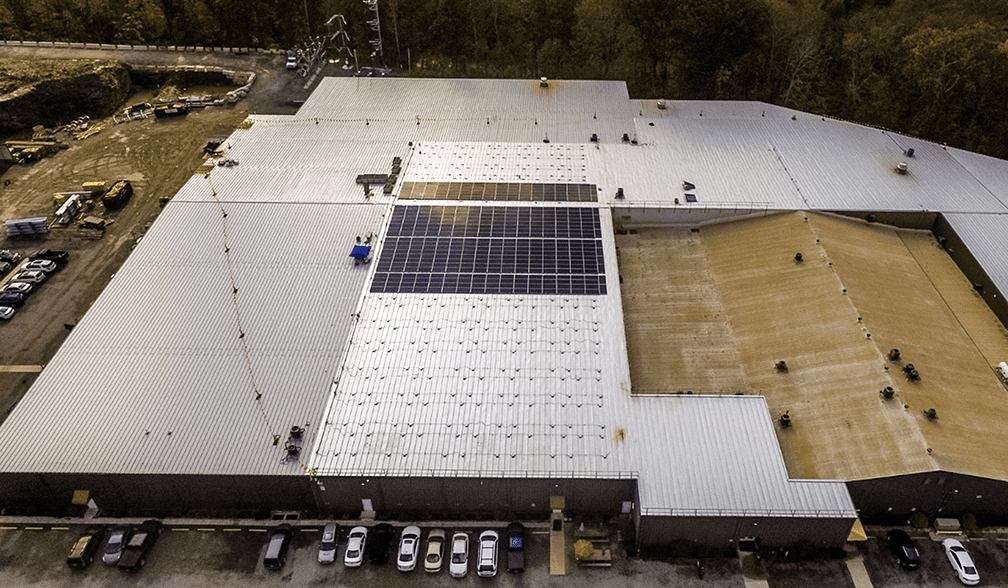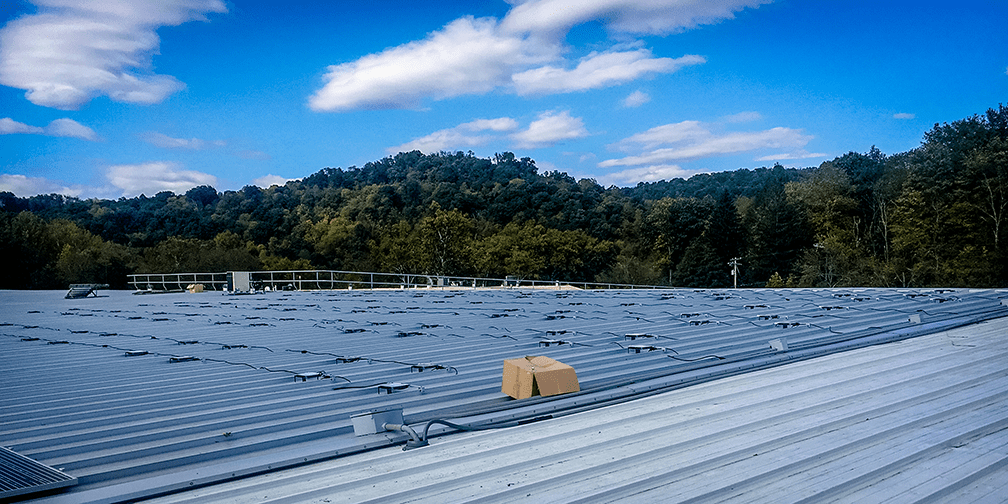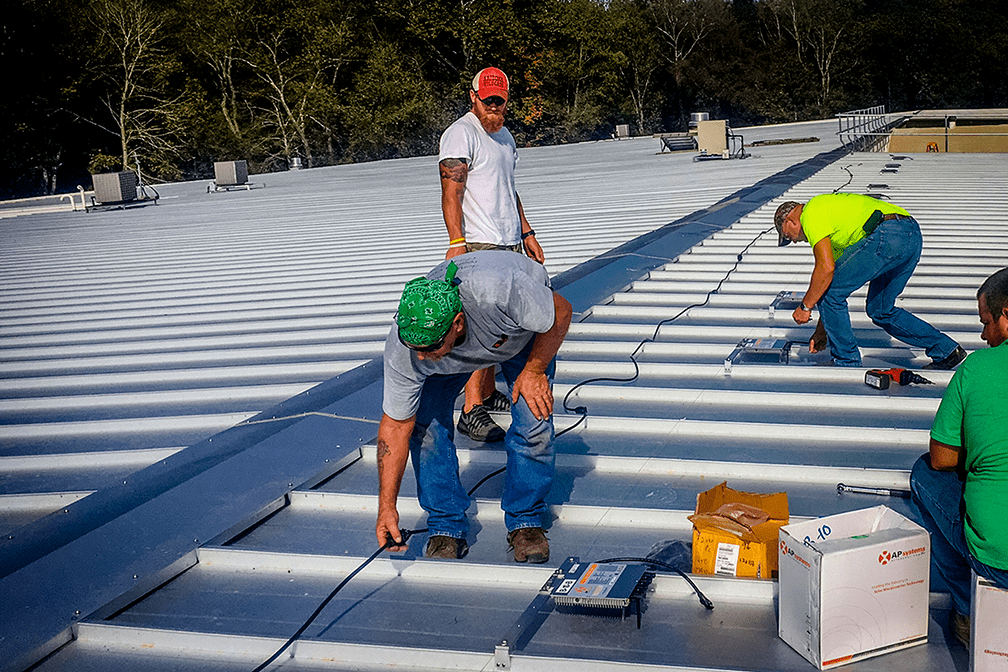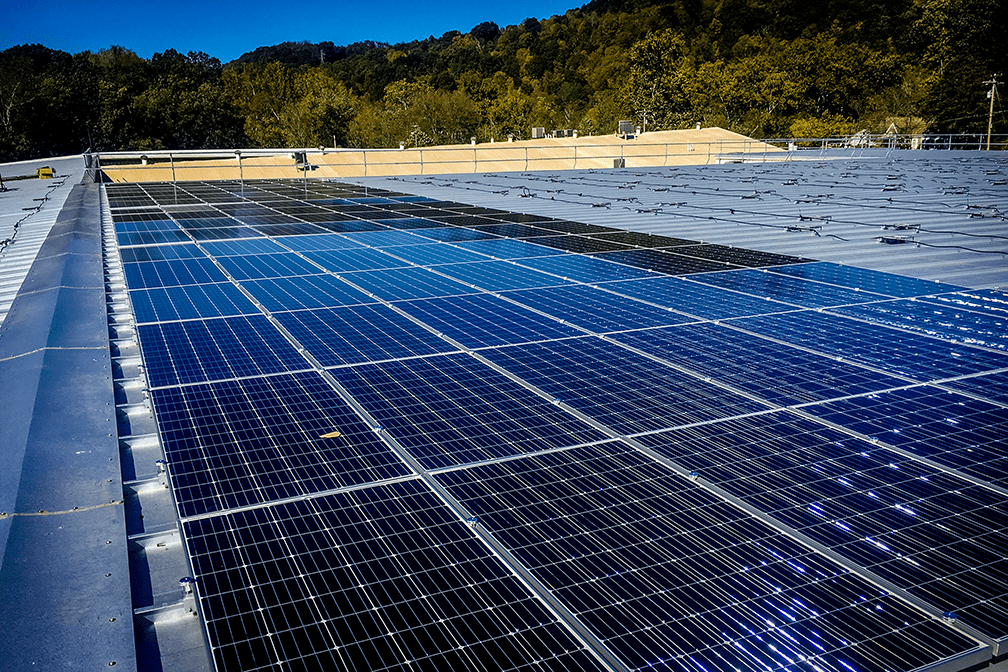When your customers are electrical utilities, you tend to think of power on a grand scale.
So no surprise the new solar array at Pennsylvania’s Cleaveland/Price switch manufacturing plant will take its place as one of the larger solar arrays on the local grid: 673kW.

“We knew that the project would take a lot of manpower and planning. However, we also knew that Cleaveland/Price could engineer a system that was efficient enough to be energy friendly while saving costs on a regular basis. Our long-term goal is to produce 100 percent of our electrical energy consumption, using solar power at a substantially lower cost,” said Trish Conboy, Cleaveland/Price marketing director. “We will see success in being energy independent, while being environmentally friendly. Cleaveland/Price will be capable of manufacturing with substantially lower energy costs. This will result in sustained company growth and lower product costs to customers.”
Cleaveland/Price manufactures a range of high-voltage switch products for power utilities nationwide. The company’s sprawling manufacturing complex sits in a glade off forested Route 993 in Trafford, Penn., east of Pittsburgh.
The idea for solar came less than a year ago, Conboy said, when Cleaveland/Price realized solar power costs less than purchased power, regardless of Pittsburgh’s cloudy conditions.
“Most people in the Pittsburgh area assume that solar will not work,” she said. “The fact is, solar does work in Pittsburgh and can cost less than what utilities charge for power.”

The first step was construction of a new standing-seam roof, covering most of the plant’s eight-building layout and providing the ideal platform for an expansive array.
Cleaveland/Price engineers designed the 2,245-module array themselves, and will handle the final electrical hookup. Local contractor Don Miller, Inc., was hired to complete the installation of modules and microinverters, which began in late September and should be completed by mid-autumn.
The array features Neo Solar Power 360W, 72-cell monocrystalline modules.
APsystems YC1000 microinverters were chosen for their true 3-phase power handling and multi-module design. Each unit will handle three modules, simplifying the installation.
Steve Cleaveland, company principal, said the APsystems units also offer low-voltage startup, an advantage over string systems and boosting solar harvest.
“It only takes 22V to start up the microinverter to produce AC, so it is ideal for Pittsburgh’s cloudy and low-light days,” he said.

Cleaveland/Price’s engineering expertise also led to an innovative racking solution, with a combination of off-the-shelf and custom-fabricated parts.
Microinverters are installed on “bridge” brackets between two Power Wide Clamps, with modules connected using a power bolt in combination with a power clamp, both from Solar Connections International. Cleaveland/Price’s own CNC team fabricated the 748 connecting “bridge” brackets in-house.
When completed, the array’s first phase will power about 30 percent of the facility’s demand. The second phase will power the remaining demand, while the final phase will power the warehouse.
Thanks to Pennsylvania’s net-metering allowance, the array should allow Cleaveland/Price to “bank” power on weekends and evenings when the facility is closed.
“We designed or purchased all equipment,” Conboy said. “This resulted in a low-cost solar array, with a less than four-year return on investment. This includes the 30 percent first-year federal tax credit on renewable energy.”
LEADER IN HIGH-VOLTAGE SWITCHES
Cleaveland/Price has been serving the power utility industry since 1975, when founder Chuck Cleaveland started supplying parts for switches that had been discontinued by electrical giant Westinghouse.
Being engineers, the Cleaveland/Price team began improving on the original designs and manufacturing its own product line. Over time that led to a full portfolio of custom switches and components rated up to 345kV, for a variety of utility applications.
Their reputation for reliability has been a major factor fueling their growth. No matter where you live in the United States, you may well drive past a Cleaveland/Price product at some point during your day.
The Cleaveland/Price solar field will be among the larger grid-tied arrays on the local West Penn Power system. It will join other high-profile commercial solar arrays in a growing regional market.
A 1.9MW solar field developed by Crayola powers that company’s crayon factory in Easton, Penn., while Lincoln Financial Field, home to the NFL’s Philadelphia Eagles, boasts an 11,000-module, 3MW array. Among utility-scale projects, Community Energy’s 6MW Keystone installation in Lancaster County provides clean power for an estimated 950 homes.

As a state, Pennsylvania has climbed five places to No. 19 in total solar capacity nationwide, thanks to the completion of 38.8MW worth of new projects in 2016, the Solar Energy Industries Association says. An estimated 568MW will be developed in Pennsylvania over the next five years, SEIA projects.
Cleaveland/Price manufacturing plant
Location: Trafford, Penn.
Capacity: 673kW
Modules: Neo Solar Power 360W, 72-cell monocrystalline
Number of modules: 2,245
Microinverters: APsystems YC1000 true 3-phase
No. of microinverters: 748
System designer: Cleaveland/Price
Installer: Don Miller, Inc.
 Vegas, Here We Come!July 22, 2025 - 11:40 pm
Vegas, Here We Come!July 22, 2025 - 11:40 pm Meet Solar PupAugust 7, 2025 - 5:57 am
Meet Solar PupAugust 7, 2025 - 5:57 am APsystems Featured in Solar Builder: Leading the Charge on AI in SolarAugust 7, 2025 - 6:21 am
APsystems Featured in Solar Builder: Leading the Charge on AI in SolarAugust 7, 2025 - 6:21 am TEDDY Talks Takes Scottsdale: Two New Episodes Live!August 7, 2025 - 5:53 am
TEDDY Talks Takes Scottsdale: Two New Episodes Live!August 7, 2025 - 5:53 am Review APsystems & Win a $50 Starbucks Card!August 4, 2025 - 2:35 am
Review APsystems & Win a $50 Starbucks Card!August 4, 2025 - 2:35 am



Sylvan Star Cheese Factory
/in Case Studies, General News/by APsystems TeamCanadian cheese maker Sylvan Star’s gouda has a secret ingredient: the sun.
The Red Deer, Alberta’s plant is powered by a massive solar array featuring APsystems YC1000 true 3-phase microinverters. The owners worked with local installer CarbonBite Innovations and National Solar Distributors of Edmonton toward achieving a 100-percent solar, net-zero installation. The 460-module, 122kW array was commissioned in 2016 and now powers the processing of popular and award-winning cheeses for the dairy operation.
See a video feature on the project here.
Location: Red Deer, Alberta, Canada
Installation Date: 2016
Installer : CarbonBite Innovations, Alberta
Number of modules: 460
Module brand/wattage: Canadian Solar 265W CX6P-265P
System capacity (kw): 122kWDC or 115kW AC
Microinverter: APsystems YC1000-208V
No. of Microinverters: 115
APsystems joins Sunnova Approved Vendor List
/in General News, Press Releases/by APsystems TeamFOR IMMEDIATE RELEASE
SEATTLE, Washington – January 30, 2018 – APsystems joined the approved vendor list for Sunnova, a leading U.S. residential solar and energy storage service provider.
The agreement brings APsystems advanced microinverter technology to Sunnova’s portfolio of top-tier, consumer-friendly solar services. Sunnova offers an array of solar lease, lease-to-own, and power-purchase options for customers all across the United States.
“Sunnova has earned a strong reputation for easy, no-nonsense solar packages for consumers,” said Jason Higginson, Senior Director of Marketing for APsystems USA. “We’re glad to bring our solar microinverter technology to their platform, to help more homeowners nationwide enjoy energy self-sufficiency and savings.”
“Our goal is to offer our customers a brilliant choice for energizing their lives,” said John Santo Salvo, SVP of Channel Operations and Chief Procurement Officer at Sunnova. “We believe APsystems’ advanced microinverter offering is an ideal addition to our customer-empowering portfolio of solar solutions.”
APsystems is listed on Sunnova’s 2018 Approved Vendor List and is now an option in their system solution platform.
_________________
About Sunnova
Sunnova is a leading U.S. residential solar and storage service provider whose mission is to help power solar, savings, reliability and most importantly, life, forward. Offering various rooftop solar system solutions, Sunnova provides its customers with the opportunity to customize their own systems. Sunnova isn’t simply a solar company, but a power provider that offers people a brilliant choice for energizing their lives. For more information, visit www.sunnova.com.
APsystems microinverters touted in Solar Builder magazine
/in General News, Press Coverage/by APsystems TeamAPsystems microinverters get a shout-out in the January edition of Solar Builder magazine, on newsstands and online now.
Tim Bailey, founder of Blue Frog Solar, a leading APsystems distributor, touts microinverters as a great way for smaller installers to lower soft costs by simplifying residential system design—a big advantage over complex string inverter systems.
“Microinverters are flexible, and installers can design in the field by adding modules as they see fit,” Bailey says.
Read Solar Builder’s “Ask A Distributor” feature online here.
See APsystems at Solar Power Northeast, Feb. 5-6 in Boston
/in Events, General News/by APsystems TeamAPsystems brings the groundbreaking YC600 smart-grid and Rule 21 compliant microinverter to Solar Power Northeast, Feb. 5 in Boston.
Setting a bold new standard for microinverter technology, the YC600 boasts an unprecedented 300VA peak output per channel with 60- and 72-cell PV modules. A wider MPPT voltage range than competing brands means greater energy harvest for homeowners, and the unit is shelled in a rugged, NEMA 6/IP67, powder-coated aluminum enclosure, bucking today’s trend of plastic casings. The YC600 builds on the successful APsystems line of multi-module microinverters, simplifying installation while reducing installation costs and time on the job site. See the YC600 at booth No. 405.
Contact sales.usa@APsystems.com to set up a meeting during the convention, or just come by the booth and meet the APsystems team.
Solar Power Northeast is designed to serve and advance the PV solar market, by bringing together PV industry leaders, professionals, manufacturers, and service providers to explore business solutions, new technologies, policy initiatives, and other market factors.
Information: www.events.solar.
2017 Project of the Year Competition – $1,000 Award
/in Contests, General News/by APsystems TeamDear APsystems installer,
It’s been another great year for APsystems and we have you, our solar partners, to thank for it. You’ve put our advanced microinverter technology to work for customers in markets across the country.
Now it’s time once again to look back on the great solar successes of the past year and share your very best stories with the industry and the world.
Tell us about your very best project – what set it apart in terms of scale, design, power output, challenging conditions, or your creative application of APsystems microinverter technology.
We’d like you to submit the project details here, including a brief write-up about your best installation, or more – enter all the projects you like. Remember to include some high-res photographs and any close-ups showing our microinverters in action. Your project can be completed or still in process. Entries will be judged by our APsystems team.
We’ll be honoring top projects in both Residential and Commercial categories.
And we’ll announce the APsystems Solar Project of the Year Award winners early in the new year through announcements and promotions that will highlight your project and your company. APsystems is committed to helping you grow your solar business even as we grow ours, so this is a cross-promotion opportunity you’ll definitely want to take advantage of.
The winner in each category will receive $1,000.
Our contest last year generated great interest from installers and brought out some fantastic projects; you can see the winners here.
Now we’re excited to present this competition, highlighting the very best APsystems microinverter installations of 2017.
Submit your project entries here by January 5th 2018. Please read the terms and conditions before entering.
If you have any questions, please contact our marketing coordinator.
Happy Holidays from APsystems
/in General News/by APsystems TeamBest wishes for a joyous holiday season and a very bright and happy New Year.
– Your friends at APsystems
Completed Solar Install for Pennsylvania switch manufacturing plant
/in Case Studies, General News/by APsystems TeamMore than 2,200 solar modules … 673kW of power … and only one microinverter that could handle the job – the APsystems YC1000.
Congratulations to Cleaveland/Price for completing this impressive commercial array at their Pennsylvania switch manufacturing plant, using the industry’s leading true 3-phase microinverter.
Read full project installation story here.
DCIM100MEDIADJI_0003.JPG
Proud to support Extend the Day for Rohingya Refugee relief #GivingTuesday
/in General News/by APsystems TeamExtend the Day hopes to provide 10,000 handheld solar lamps for refugee families and children now living without electricity or other basic services. With these simple, inexpensive devices, we can help people in crisis benefit from clean, renewable solar power to improve their day-to-day lives.
APsystems is proud to support Extend the Day in its mission to bring the gift of solar lighting to this outstanding organization. One dollar from the purchase of every APsystems microinverter goes to Extend the Day to provide these small but powerful solar lamps.
During this holiday season and on this #givingtuesday, please consider a donation to Extend the Day through its online fundraising campaign to provide 10,000 solar lights to Rohingya refugees.
Happy Thanksgiving
/in General News/by APsystems TeamDuring this season of thanksgiving, may you and yours harvest more than just energy, but peace, love and joy as well.
APsystems powers massive 3-phase array at Pennsylania’s Cleaveland/Price plant
/in Case Studies, General News/by APsystems TeamWhen your customers are electrical utilities, you tend to think of power on a grand scale.
So no surprise the new solar array at Pennsylvania’s Cleaveland/Price switch manufacturing plant will take its place as one of the larger solar arrays on the local grid: 673kW.
“We knew that the project would take a lot of manpower and planning. However, we also knew that Cleaveland/Price could engineer a system that was efficient enough to be energy friendly while saving costs on a regular basis. Our long-term goal is to produce 100 percent of our electrical energy consumption, using solar power at a substantially lower cost,” said Trish Conboy, Cleaveland/Price marketing director. “We will see success in being energy independent, while being environmentally friendly. Cleaveland/Price will be capable of manufacturing with substantially lower energy costs. This will result in sustained company growth and lower product costs to customers.”
Cleaveland/Price manufactures a range of high-voltage switch products for power utilities nationwide. The company’s sprawling manufacturing complex sits in a glade off forested Route 993 in Trafford, Penn., east of Pittsburgh.
The idea for solar came less than a year ago, Conboy said, when Cleaveland/Price realized solar power costs less than purchased power, regardless of Pittsburgh’s cloudy conditions.
“Most people in the Pittsburgh area assume that solar will not work,” she said. “The fact is, solar does work in Pittsburgh and can cost less than what utilities charge for power.”
The first step was construction of a new standing-seam roof, covering most of the plant’s eight-building layout and providing the ideal platform for an expansive array.
Cleaveland/Price engineers designed the 2,245-module array themselves, and will handle the final electrical hookup. Local contractor Don Miller, Inc., was hired to complete the installation of modules and microinverters, which began in late September and should be completed by mid-autumn.
The array features Neo Solar Power 360W, 72-cell monocrystalline modules.
APsystems YC1000 microinverters were chosen for their true 3-phase power handling and multi-module design. Each unit will handle three modules, simplifying the installation.
Steve Cleaveland, company principal, said the APsystems units also offer low-voltage startup, an advantage over string systems and boosting solar harvest.
“It only takes 22V to start up the microinverter to produce AC, so it is ideal for Pittsburgh’s cloudy and low-light days,” he said.
Cleaveland/Price’s engineering expertise also led to an innovative racking solution, with a combination of off-the-shelf and custom-fabricated parts.
Microinverters are installed on “bridge” brackets between two Power Wide Clamps, with modules connected using a power bolt in combination with a power clamp, both from Solar Connections International. Cleaveland/Price’s own CNC team fabricated the 748 connecting “bridge” brackets in-house.
When completed, the array’s first phase will power about 30 percent of the facility’s demand. The second phase will power the remaining demand, while the final phase will power the warehouse.
Thanks to Pennsylvania’s net-metering allowance, the array should allow Cleaveland/Price to “bank” power on weekends and evenings when the facility is closed.
“We designed or purchased all equipment,” Conboy said. “This resulted in a low-cost solar array, with a less than four-year return on investment. This includes the 30 percent first-year federal tax credit on renewable energy.”
LEADER IN HIGH-VOLTAGE SWITCHES
Cleaveland/Price has been serving the power utility industry since 1975, when founder Chuck Cleaveland started supplying parts for switches that had been discontinued by electrical giant Westinghouse.
Being engineers, the Cleaveland/Price team began improving on the original designs and manufacturing its own product line. Over time that led to a full portfolio of custom switches and components rated up to 345kV, for a variety of utility applications.
Their reputation for reliability has been a major factor fueling their growth. No matter where you live in the United States, you may well drive past a Cleaveland/Price product at some point during your day.
The Cleaveland/Price solar field will be among the larger grid-tied arrays on the local West Penn Power system. It will join other high-profile commercial solar arrays in a growing regional market.
A 1.9MW solar field developed by Crayola powers that company’s crayon factory in Easton, Penn., while Lincoln Financial Field, home to the NFL’s Philadelphia Eagles, boasts an 11,000-module, 3MW array. Among utility-scale projects, Community Energy’s 6MW Keystone installation in Lancaster County provides clean power for an estimated 950 homes.
As a state, Pennsylvania has climbed five places to No. 19 in total solar capacity nationwide, thanks to the completion of 38.8MW worth of new projects in 2016, the Solar Energy Industries Association says. An estimated 568MW will be developed in Pennsylvania over the next five years, SEIA projects.
Cleaveland/Price manufacturing plant
Location: Trafford, Penn.
Capacity: 673kW
Modules: Neo Solar Power 360W, 72-cell monocrystalline
Number of modules: 2,245
Microinverters: APsystems YC1000 true 3-phase
No. of microinverters: 748
System designer: Cleaveland/Price
Installer: Don Miller, Inc.